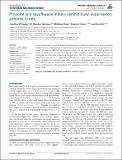Propofol and sevoflurane induce distinct burst suppression patterns in rats
Author(s)
Westover, M. Brandon; Ching, ShiNung; Brown, Emery N.; Solt, Ken; Kenny, Jonathan Dillion
DownloadKenny-2014-Propofol and sevoflu.pdf (1.700Mb)
PUBLISHER_CC
Publisher with Creative Commons License
Creative Commons Attribution
Terms of use
Metadata
Show full item recordAbstract
Burst suppression is an EEG pattern characterized by alternating periods of high-amplitude activity (bursts) and relatively low amplitude activity (suppressions). Burst suppression can arise from several different pathological conditions, as well as from general anesthesia. Here we review current algorithms that are used to quantify burst suppression, its various etiologies, and possible underlying mechanisms. We then review clinical applications of anesthetic-induced burst suppression. Finally, we report the results of our new study showing clear electrophysiological differences in burst suppression patterns induced by two common general anesthetics, sevoflurane and propofol. Our data suggest that the circuit mechanisms that generate burst suppression activity may differ among general anesthetics.
Date issued
2014-12Department
Harvard University--MIT Division of Health Sciences and Technology; Massachusetts Institute of Technology. Department of Brain and Cognitive SciencesJournal
Frontiers in Systems Neuroscience
Publisher
Frontiers Research Foundation
Citation
Kenny, Jonathan D., M. Brandon Westover, ShiNung Ching, Emery N. Brown, and Ken Solt. “Propofol and Sevoflurane Induce Distinct Burst Suppression Patterns in Rats.” Front. Syst. Neurosci. 8 (December 18, 2014).
Version: Final published version
ISSN
1662-5137